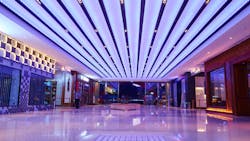LED Lighting Design Has Never Been Easier (.PDF Download)
Application of LED lighting is more common these days, especially in homes and in some new buildings, as standard incandescent and fluorescent lighting continue to fade away. It’s not so dominant in older commercial and retail buildings or in industrial settings yet, but the trend is there. And with the new products available today, it’s become substantially easier to design and build industrial and new building lighting products and systems.
Lighting used to be so simple. You screwed a light bulb into a socket and applied ac and, voila’, light. Modern lighting now comes from a sophisticated semiconductor device called a light emitting diode (LED) with complex electronic circuits to power and control it. The rationale for this extra complexity and cost is electrical efficiency. LEDs provide the same if not more light intensity, but it’s far more efficient. It uses less energy and generates much less heat than older, more traditional lighting products.
